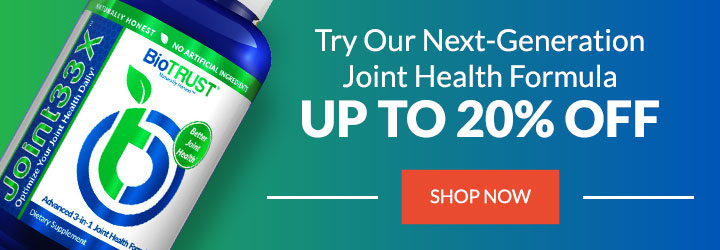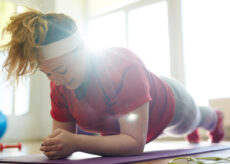5 Ways to Naturally Reduce Muscle Soreness and Joint Discomfort

For most of us, exercise-related muscle soreness or occasional activity-related joint flare-ups are “facts of life.” I have a friend, Don, who just turned 69 last week, and he’s always telling me, “Getting old ain’t for wimps.” In other words, we just come to expect age-related aches, pains, and stiffness as inevitable. Among the laundry list of things we just have to learn to tolerate as we get older.
But what if they’re not? What if you didn’t have to rely on popping over-the-counter pills—which another friend in his 70’s calls “my generation’s skittles”—to dampen the screaming sound of your muscles and joints? Which, by the way, can lead to a slew of adverse side effects, including digestive complications like leaky gut and ulcers.1
Good news: There are several ways you can help your body naturally recover and handle everyday aches and activity-related flare-ups. And as Don regularly reminds me just by example, getting a bit older doesn’t have to mean slowing down. Not one bit. He continues to run, mountain bike, ride his trials motorcycles, lift weights, and much more while running his own successful business.

Nutrition
To ease age-related joint discomfort and accelerate recovery, we need to manage oxidative and inflammatory stress. That is, we need to improve our antioxidant status and support healthy levels of inflammation.
In addition to a poor diet, inflammatory stress can be caused by carrying around extra body fat. You see, body fat is not just a depot for fat storage. It also releases inflammatory chemicals. On top of that, excess weight puts extra stress on your joints. Being just 10 pounds overweight can mean an additional 30 – 60 pounds of force on the knees with each step.2
That said, research is showing now, more than ever, that food can be incredibly useful and effective for nourishing joints. According to joint health expert Dr. Jason Theodosakis (Dr. Theo), “We now know certain foods can actually help promote joint comfort.”3
According to Dr. Theo, foods that contain vitamin A (e.g., beta-carotene), vitamin C, vitamin E, and/or selenium (collectively known as the “ACES”) are powerful weapons against free radicals and achy joints.
Several antioxidant phytonutrients (e.g., flavonoids, anthocyanins, carotenoids, plant sterols, glucosinolates) found in a variety of plant-based foods are tremendously beneficial for joint health. They support the body’s antioxidant defense systems, reduce oxidative stress, and promote a healthy inflammatory response. In addition, other micronutrients (e.g., vitamin D, vitamin K, several B vitamins) may play critical roles in optimizing joint health and function.4
What’s more, certain fats (e.g., omega-3 fatty acids) promote a healthy inflammatory response and ease joint discomfort.
With all that in mind, here are some of the top foods to help support your body’s ability to combat everyday muscle and joint aches:
- Avocados
- Extra virgin olive oil
- Cherries
- Apples
- Blueberries, strawberries, and other berries
- Red wine (in moderation, of course)
- Coldwater fatty fish
- Broccoli and other cruciferous veggies
- Brazil nuts and other nuts
- Dairy, yogurt, and other fermented foods
- Dark green leafy veggies
- Orange-colored fruits and veggies (carrots, pumpkin, sweet potatoes, papaya)
- Citrus fruits
- Pineapples
- Whey protein
- Bone broth
Combine these foods with an overall healthy diet, plenty of clean water, stress management, and as many of the following as possible, and you’ll be on the right track!

Exercise
Have you ever noticed that once you get moving, your workout-related muscle soreness seems to go away or at least diminish noticeably? More than once, Strength Coach Dan John has said, “The best tonic for soreness is the movement that got you sore in the first place.”
Indeed, several studies have shown low-intensity exercise has a temporary pain-relieving effect on exercise-related muscle soreness.5–7 Many people find low-level activity provides immediate relief. So, if you’re experiencing some day-after muscle soreness, consider taking a walk, doing some body weight movement, or even doing some exercises with resistance bands.
What about stretching? Good question. Admittedly, the research is not all that favorable in terms of stretching to reduce muscle soreness—at least not in one session. Yet while a bout of stretching may not be all that effective, when performed regularly and properly, a well-designed flexibility program can, in fact, reduce joint discomfort and the likelihood of injuries and low-back pain.
On a related note, if you find a certain movement causes discomfort, there’s a good chance you need some help learning to rewire how you move. In this case, seek out a qualified movement professional or physical therapist, who may be able to help a lot with an individualized program.
According to renowned physical therapist Kelly Starrett, “Movement and pain get mapped. If you experience pain during a given movement for a month, for instance, it’s a chronic pain condition. Your brain starts to map the pain pathway with the movement motor pathway, and those become conjoined. The brain starts to remember the movement that created pain (got you injured). Even if there is no trauma, every time you move that particular way, you still get the pain sensation. So, one of the ways we’re able to help people get out of chronic pain is to give them a new motor program (e.g., don’t squat with your knees in).”8

Supplements
Given its antioxidant and anti-inflammatory properties, it’s no surprise curcumin, found in turmeric, is highly regarded for reducing joint discomfort. In one 3-month trial, researchers found those supplementing with curcumin daily enjoyed significant improvements in joint comfort and mobility.9 In fact, the curcumin group experienced a 58% reduction in joint discomfort. The placebo group, on the other hand, experienced a modest 2% improvement. Meanwhile, the curcumin group improved mobility (studied by walking performance on a treadmill) by 337%. The placebo group only improved by 57%.
What’s more, a series of studies show supplementing with curcumin for 8 weeks significantly decreases muscle damage and soreness after intense exercise training. Curcumin supplementation was then shown to reduce the decrease in physical performance that follows damaging exercise. In other words, curcumin supplementation accelerates recovery, so athletic performance is restored more quickly.10,11
For athletes and anyone concerned with performing at a high level, these findings are very important. Inadequate recovery means more soreness, which leads to reduced range of motion, decreased strength and power, poor balance, increased risk of injury, and overall reduction in physical performance.12 On the other hand, curcumin may help you train and compete harder, more frequently.
Another personal favorite supplement is Joint 33X. This blend of three revolutionary joint-nourishing nutrients (backed by more than 10 clinical trials) has demonstrated superior ability to revitalize and re-energize joints by addressing the root causes. Plus, it’s been shown to enhance recovery from exercise and physical activity.
Joint 33X contains UC-II®, an effective form of collagen shown in four human clinical trials to improve joint comfort, mobility, and flexibility. UC-II has even been shown to be more effective than glucosamine and chondroitin in head-to-head research.13–16
Joint 33X also contains Hyal-Joint®, which significantly reduces joint discomfort. It does this by helping lubricate and cushion joints, reduce friction, and improve ease of movement.17 Finally, Joint 33X contains AprèsFlex®. It helps protect joints from collagen-degrading enzymes. AprèsFlex has been shown to lead to significant improvements in joint comfort and stiffness in less than a week!18,19
In addition, the following supplements may also help accelerate recovery from exercise while helping reduce muscle soreness:
- BCAAs20–23
- Bromelain24
- Citrulline25
- Ginger26
- Omega-3 Fatty Acids (EPA and DHA)27
Remember, supplements support a solid, consistent foundation of healthy habits, like good nutrition, restorative sleep, and stress management rather than replace those habits.

Hot and Cold Therapy
One of the most popular recommendations to help reduce soreness, relieve pain, and decrease inflammation is to ice. Whether that’s with cold-water immersion (soaking in a cold tub), ice packs, or whole-body cryotherapy (exposing the body to vapors that reach ultra-low temperatures from minus 200 to minus 300 degrees Fahrenheit), cold therapy is thought to impact tissue temperature, blood flow, pain, and swelling.28
Despite its popularity, the results of cold therapy on muscle soreness are mixed.6,29–31 Having said that, several studies have indeed shown it can reduce exercise-related muscle soreness after exercise. Interestingly, there’s some evidence that whole-body cryotherapy (WBC), which is gaining popularity, may make the pain worse. So, if you experiment with cold therapy, consider different methods (ice packs, cold-water immersion, WBC) to see how they work for you.
On the other side of the rice pack, heat has been used therapeutically for thousands of years to immediately relieve discomfort and increase blood flow to speed recovery.32,33 One recent study compared the effects of dry heat (heat packs) to moist heat (warm-water therapy) on muscle soreness after exercise. While both were effective, the researchers found moist heat (sitting in a 105-degree hot tub) resulted in the greatest relief from post-exercise soreness. What’s more, the enhanced benefits were felt 25% of the time (compared to dry heat).33
Although it’s not nearly as popular as cold therapy for reducing muscle soreness, sauna bathing is gaining attention as an effective tool to promote recovery and relieve exercise-related pain. Unlike local application of heat (e.g., heat pad), sauna bathing hits the whole body, warming up muscles and increasing tissue temperature. In that sense, it’s similar to a full-body warmup.
Along those lines, sauna bathing is thought to benefit the body’s circulatory, immune, endocrine (hormone), and neuromuscular systems. In one recent study, researchers from Thailand found folks who sat in the sauna before intense exercise experienced both reductions in pain intensity and improvements in muscle function. In other words, sauna bathing appeared to reduce exercise-related muscle soreness and facilitate recovery.34
You may be wondering…which is better, hot or cold? Well, there’s not a clear-cut “winner” when it comes to reducing exercise-related muscle soreness. One study published in the Journal of Strength and Conditioning Research compared the two. The researchers found “both cold and heat appeared to be effective in reducing muscle damage after exercise.” Having said that, they did find cold appeared to be more effective than heat when applied 24 hours after exercise.35
The moral of the story is to experiment with both hot and cold—including the different types in each category—to find what works best for you.

Massage Therapy
Last but certainly not least, massage therapy is often believed to be the best, most effective tool to reduce muscle soreness.6,7 Interestingly, while massage therapy is widely used and commonly recommended by coaches and therapists, theories on why it may be effective are obscure. Be that as it may, it seems like massage therapy works. And you have to admit, a good massage feels pretty great. Let’s take a look at some of the actual research…
In a study published in the Journal of Athletic Training, Australian researchers found a 10-minute massage 3 hours after exercise resulted in a 30% reduction in muscle soreness and swelling.36
In another study published in the Journal of Strength and Conditioning Research, researchers found 10 minutes of massage 48 hours after intense exercise significantly reduced the intensity of soreness and pain sensitivity. What was particularly interesting about this study was the researchers also found 10 minutes of active exercise (with resistance bands) similarly reduced muscle soreness and pain sensitivity. In other words, either massage or an active warmup can acutely reduce muscle soreness, with the greatest effect about 20 minutes after treatment, which seems to last about an hour.
Fight Back Against Muscle Soreness
So, if you’re looking to accelerate recovery from exercise, reduce muscle soreness, and combat age- and activity-related joint aches and flare-ups, consider adding these natural alternatives to your arsenal…and get back to doing what you love to do…better…and faster!







